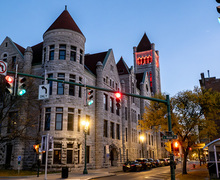SU forms research partnership with Nanjing University in China to study urban building design, environment
Courtesy of Steve Sartori
Representatives from both the Syracuse University Center for Excellence and Nanjing University in China sign a memorandum of understanding cementing the researching partnership between the two schools.
Syracuse University and Nanjing University in China have signed an agreement to form the International Center for Green Buildings and the Urban Environment.
The center will focus on three main areas: research, education and outreach, said Jensen Zhang, a professor of mechanical and aerospace engineering and the SU director of the International Center for Green Buildings and the Urban Environment. The center is located at the SU Center of Excellence, and Nanjing University has also dedicated office space in China for the center.
The center’s current research activities include urban building design and how it impacts environmental quality, building materials and how they affect energy consumption and indoor air quality design and control strategies, Zhang said.
The U.S. and China are responsible for about 43 percent of greenhouse gas emissions, which are collective action problems that require collaboration, said Sherburne Abbott, vice president for sustainability initiatives at SU.
“It is important that we have a collaborative relationship to help us share knowledge, information and new approaches to technology and policy that advance the visions of clean energy, sustainability and climate mitigation,” Abbott said.
Despite the fact that there are often disagreements between Beijing and Washington, D.C. on economic and security issues, academic exchange is an area that continues to grow, said Terry Lautz, a visiting professor at SU and director of the East Asia Program of the Moynihan Institute of Global Affairs.
“This is an extremely important priority for China because of the severe problems they have with pollution — air, water and ground,” Lautz said. “There is a clear mutual interest not only on the part of our universities, but on the part of our two governments.”
During President Barack Obama’s visit to China last year, he and Chinese President Xi Jinping signed a historic agreement to work jointly on the issue of climate change. They reaffirmed their commitment ahead of the Paris climate talks during Jinping’s visit to Washington, D.C. in September, according to a White House statement.
The center has received several proposals for additional projects, said Zhang, the SU director of the center.
“We’re looking at the projects that have the most potential for impact on environmental quality and energy efficiency,” Zhang said. “There also has to be significant interest from faculty participating in the project.”
Zhang added that funding is also a challenge, and the center will be looking at a variety of sources to sustain this research.
For the education component, the center is developing an exchange program that includes a set of identified courses related to green buildings and urban environment, including virtual design and studio courses jointly offered by SU and Nanjing University faculty, Zhang said.
Ultimately, the center plans to develop certificate, minor and Master of Science programs in integrated design, Zhang said. While the certificate program is already in development, he said the other programs will require additional planning and state approval.
The center will also use outreach to commercialize the technologies developed by helping academics connect with industries through the Center of Excellence, Zhang said. In the future, Zhang said center officials hope to develop a training program for Chinese officials to come to the U.S. to learn about the principles of green building development and take tours of green buildings here.
Green buildings and urban environments require a multidisciplinary approach, Zhang said, so three different colleges are all bringing their own expertise to the center — the School of Architecture, the College of Engineering and Computer Science and the Maxwell School of Citizenship and Public Affairs. A similar multidisciplinary approach is being taken at Nanjing University, Zhang said.
Abbott, the vice president for sustainability initiatives at SU, said she thinks it’s only the beginning for the partnership.
“This project is more than just interesting research questions, but practical applications toward improvement in urban areas,” she said. “I think this is the beginning, and it’s going to be up to all the various parties to keep the momentum going.”
Published on November 4, 2015 at 9:35 pm
Contact Gulnaz: glnzkhan@gmail.com





